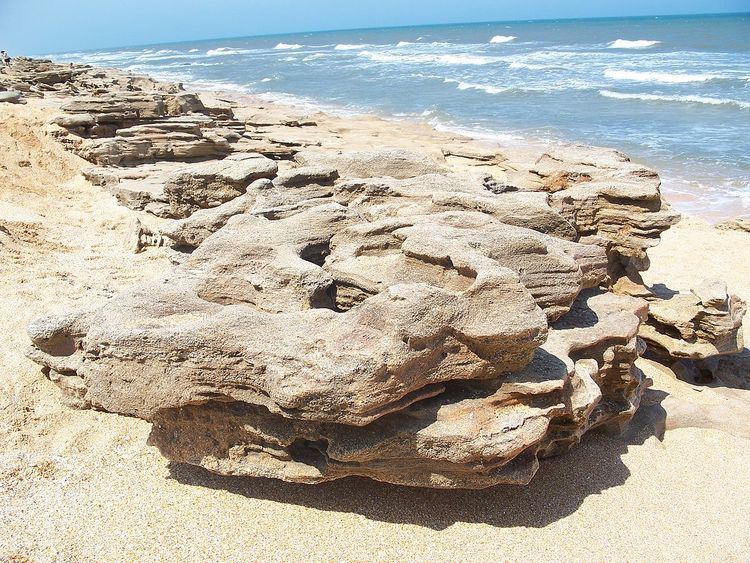 | ||
Coquina ( /koʊˈkiːnə/) is a sedimentary rock that is composed either wholly or almost entirely of the transported, abraded, and mechanically-sorted fragments of the shells of molluscs, trilobites, brachiopods, or other invertebrates. The term coquina comes from the Spanish word for "cockle" and "shellfish".
Contents
- Composition and distribution
- History and use
- Notable exposures of coquina
- Coquina in architecture
- References
For a sediment to be considered to be a coquina, the particles composing it should average 2 mm or greater in size. Coquina can vary in hardness from poorly to moderately cemented. Incompletely consolidated and poorly cemented coquinas are considered grainstones in the Dunham classification system for carbonate sedimentary rocks. A well-cemented coquina is classified as a biosparite according to the Folk classification of sedimentary rocks.
Coquinas accumulate in high-energy marine and lacustrine environments where currents and waves result in the vigorous winnowing, abrasion, fracturing, and sorting of the shells, which compose them. As a result, they typically exhibit well-developed bedding or cross-bedding, close packing, and good orientation of the shell fragments. The high-energy marine or lacustrine environments associated with coquinas include beaches, shallow submarine raised banks, swift tidal channels, and barrier bars.
Composition and distribution
Coquina is mainly composed of the mineral calcite, often including some phosphate, in the form of seashells or coral. Coquinas dating from the Devonian period through to the much more recent Pleistocene are a common find all over the world, with the depositional requirements to form a coquina being a common thing in many marine facies.
History and use
Occasionally quarried or mined and used as a building stone in Florida for over 400 years, coquina forms the walls of the Castillo de San Marcos, Saint Augustine. The stone makes a very good material for forts, particularly those built during the period of heavy cannon use. Because of coquina's softness, cannonballs would sink into, rather than shatter or puncture, the walls of the Castillo de San Marcos. The first Saint Augustine Lighthouse was also built of coquina.
Sedgely Abbey, an 18th-century plantation house on the lower Cape Fear River in North Carolina was built of locally quarried coquina. The house that once stood on a vast tract of land directly across the river from Orton was described by local historian and author James Sprunt in "Tales and Traditions of the Lower Cape Fear 1661-1896" (Le Gwin Brothers Printers, Wilmington, NC., 1896) as: "the grandest colonial residence of the Cape Fear". Sprunt compared Sedgeley Abbey in dimensions and appearance to the two-story, cellered, Governor Dudley mansion that still stands in Wilmington. Like many southern plantations, Sedgeley Abbey fell into disrepair after the Civil War. The vacant house was demolished in the 1870s and the coquina rubble was burned and used for fertilizer. A cellar eight feet deep carved into solid coquina was located during archaeological investigations on the site of the former plantation in 1978.
In the past coquina was used for the construction of buildings in Denham, Western Australia, but quarrying is no longer permitted in the World Heritage Site.
When first quarried, coquina is extremely soft. This softness makes it very easy to remove from the quarry and cut into shape. However, the stone is also at first much too soft to be used for building. In order to be used as a building material, the stone is left out to dry for approximately one to three years, which causes the stone to harden into a usable, but still comparatively soft, form.
Coquina has also been used as a source of paving material. It is usually poorly cemented and easily breaks into component shell or coral fragments, which can be substituted for gravel or crushed harder rocks. Large pieces of coquina of unusual shape are sometimes used as landscape decoration.
Because coquina often includes a component of phosphate, it is sometimes mined for use as fertilizer.
